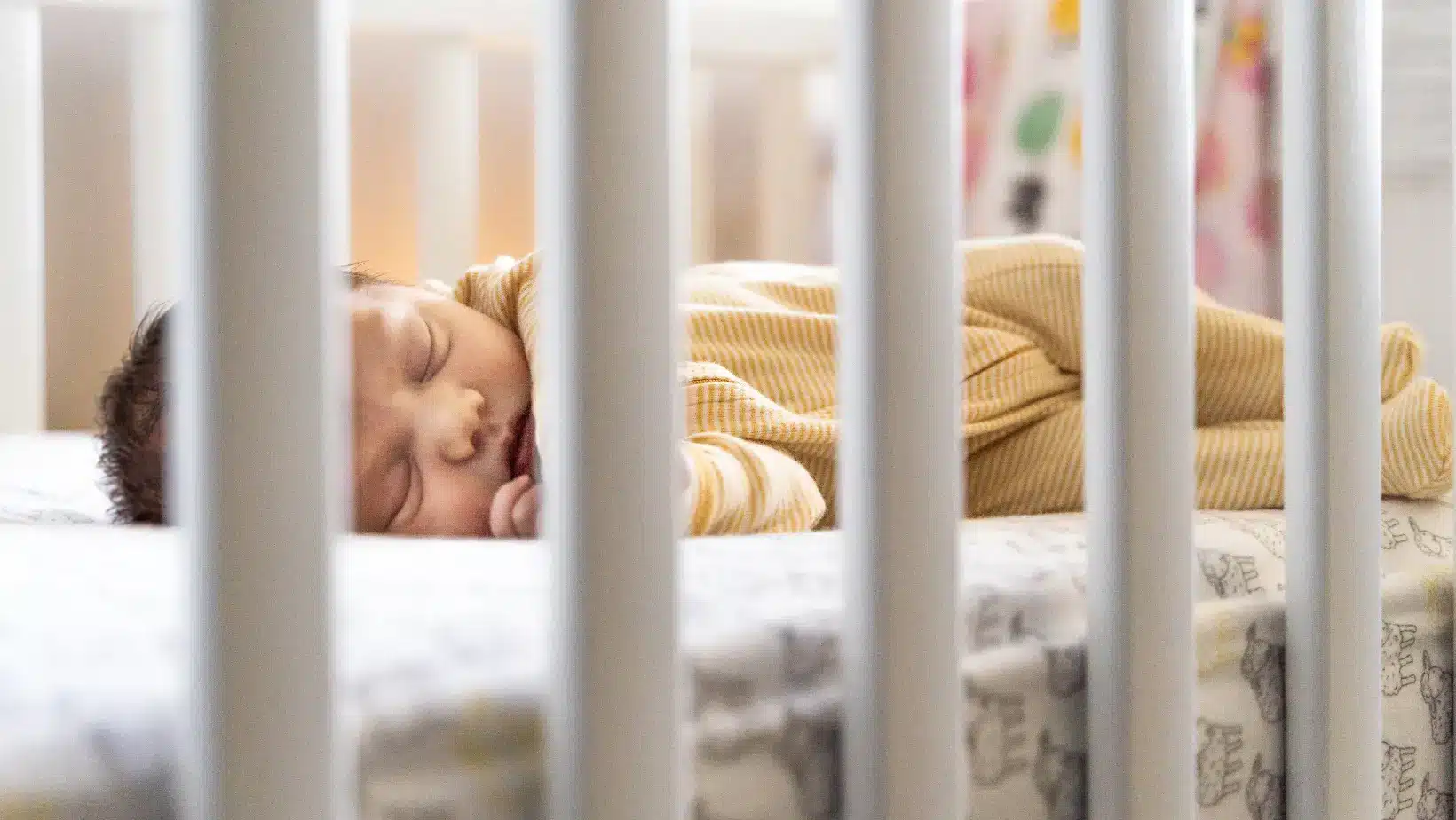Choosing the right crib and mattress for your baby can seem like a real headache, with so many options available on the market. One thing’s for sure: it’s essential to consult Health Canada’s current standards (2024) to make an informed and safe choice for your little one. This article highlights the various elements to take into account when researching, to ensure a safe final choice for your baby.
Choosing the bed
When choosing a crib for your child, it’s often the overall look, color, ease of use and price that guide you. When it comes to size, remember that all cribs are standard: in other words, although one may appear larger than the other, their interior measurements are identical!
The age of the bed
Have you been given a used bed, or found one at a garage sale?
It’s possible to use it, provided you check :
- all cribs made before 1986 should never be used, since they don’t meet the latest safety standards set by Health Canada
- they have not been part of a product recall at www.santecanada.gc.ca/rappels-spc
- there is no damage, all bolts are tight, there are no cracks or deformations, and no breakage.
In addition, since 2016, it has been illegal to sell or manufacture in Canada a crib with sides that can lower as they increase the risk of injury and death.
Current standards
- Always read the manufacturer’s instructions for assembling and never modify the crib in any way. The user manual will help you avoid errors and associated risks which can harm the safety of your baby;
- Regularly check that the crib parts are secure to avoid a weakening of the structure leading to breakage or loosening of screws, etc.;
- Make sure that the distance between the crib’s bars isn’t greater than 6 cm (1 3/8”);
- The poles at the corners of the cradle must not extend more than 1.5 cm from the top of the sides;
- Also ensure that the mattress is firm, and it’s at most 3.8 cm (1 ½”) thick;
- Make sure there’s no more than 3 cm (1 3/16”) of space between the mattress and the sides of the crib. As a general rule, two adult fingers stuck together and placed in the space between the mattress and the bars equal 3 cm!
- Remove the protective padding on the crib bars. Some very young baby’s can, as a reflex, turn in their crib; if their nose ends up in the wrapping, it can asphyxiate them. Babies can also find themselves stuck between the bars and the side of the bed. Consequently, it’s recommended to remove the protective padding until your child can turn on their own (rarely before 4–5 months) and better move about. This is why this product isn’t banned in Canada. If your baby moves around a lot and often and gets his legs or arms caught between the bars, there are mesh bar protectors that won’t hinder ventilation if he comes into contact with them.
- Remove the mobile and any other toys hanging from the cradle and lower the mattress as low as possible, as soon as baby is able to sit up unaided or crawl on all fours.
If you have to paint or stain the crib:
Use a nontoxic, water-based or natural paint or stain that won’t harm babies (see my article Stains, Paints and Pregnancy).
Good to know : All paints that have lead in them have been banned in Canada since 1950 and the presence of phthalates is also prohibited.
Choosing a mattress
To be sold in Canada, all mattresses must meet regulatory requirements, such as never being manufactured with substances harmful to health. Make sure the mattress is the right size for the bed.
Throw away any worn-out mattress or one with a visible indentation.
There are many different types of baby mattress on the market, so here are a few points to help you make your purchase :
- The weight of the mattress indicates the foam density or the number of springs;
- Baby mattresses should be firm; when you remove your hand after pressing into the mattress, it should quickly regain its original form. This firmness will help prevent suffocation if the baby ends up with their face against the mattress;
- The dimensions of the mattress are fairly standard: length: 51 5/8”, width: 27 ¼”; thickness: 6″ or less; never more than 15 cm. Never more than two adult fingers between the mattress and the bars;
- Foam mattresses are made from polyester or recycled fibres, such ecological Dura Bond or ecological biofibres, made of wool and cotton. This mattress is light and easy to move. Firm foam mattresses are very comfortable for babies.
- Helicoidal spring mattresses are heavier, as they’re made with springs covered by a layer of foam or soft cotton. The springs can often be felt through the tissue, making the mattress more uncomfortable, especially over time;o available. They’re made from natural components, organic fibres, but covered by waterproof latex. Soft cotton is used as a covering for this type of mattress. You can choose them based on your personal criteria, such as a machine washable cover, soybean-based foam, Tencel eucalyptus fibres, antifungal, microbe, mite, mould, or odour resistant, etc.;
- Natural fibre mattresses are also available. They’re made from natural components, organic fibres, but covered by waterproof latex. Soft cotton is used as a covering for this type of mattress. You can choose them based on your personal criteria, such as a machine washable cover, soybean-based foam, Tencel eucalyptus fibres, antifungal, microbe, mite, mould, or odour resistant, etc.;
- Hypoallergenic mattresses allow you to easily remove the quilted bedspread. You can machine wash them frequently at 60ᵒ C (140ᵒ F) to eliminate bacteria, mites, dust and other possible allergens. Families that have different types of allergy risks should consider them.
The bedroom: a safe place
To ensure your baby’s safety when you place them in their crib, here are some suggestions:
- Remove all objects in their bed: pillow, stuffed animals, bottle, toys, etc.;
- A mattress with a cover and sheet is often enough for a baby; if you need to add an additional cover, use one that is thin and breathable to avoid suffocation. This could occur with a cover made from bamboo tissue, for example;
- Always place the crib far from shutter or drape cords, wall lamps and electrical outlets;
- Lay your baby on their back in their crib if they’re unable to turn on their own (often arround 4-6 months); you can then let them reposition themselves;
- During the day, change where your baby sleeps to get them used to daily sounds. Place them in different positions under supervision-on their side, stomach…
Additionally, many parents ask me if the family bassinet, baby basket or cradle should be avoided. Based on the above-mentioned recommendations, we can safely place a baby in these types of beds up to about three months; just before they can completely turn over or the weigh less than the regulatory weight indicated by the manufacturer.
As for the right age to shift your baby from a crib to bed, for safety recommendations, it’s recommended that it should take place around 2 years of age or when they’re taller than 90 cm (35″). This is when they may be able to climb over the side of their crib and fall. They should be shown how to safely climb out of or into their crib by transforming it into a daybed. The transition barrier on the side of your child’s bed isn’t mandatory, but it can help both baby and parents feel more secure when transitioning from the crib to bed.
Marie Fortier
The baby expert
Updated article : February, 2025.


